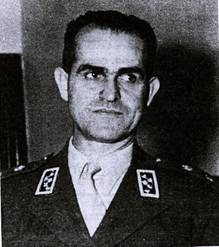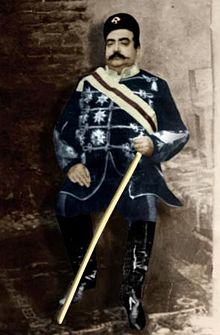
The Qajar dynasty was an Iranian dynasty founded by Mohammad Khan of the Qoyunlu clan of the Turkoman Qajar tribe.

Fath-Ali Shah Qajar was the second Shah (king) of Qajar Iran. He reigned from 17 June 1797 until his death on 24 October 1834. His reign saw the irrevocable ceding of Iran's northern territories in the Caucasus, comprising what is nowadays Georgia, Dagestan, Azerbaijan, and Armenia, to the Russian Empire following the Russo-Persian Wars of 1804–1813 and 1826–1828 and the resulting treaties of Gulistan and Turkmenchay. Historian Joseph M. Upton says that he "is famous among Iranians for three things: his exceptionally long beard, his wasp-like waist, and his progeny."

Mozaffar ad-Din Shah Qajar, was the fifth Qajar shah (king) of Iran, reigning from 1896 until his death in 1907. He is often credited with the creation of the Persian Constitution of 1906, which he approved of as one of his final actions as shah.

Naser al-Din Shah Qajar was the fourth Shah of Qajar Iran from 5 September 1848 to 1 May 1896 when he was assassinated. He was the son of Mohammad Shah Qajar and Malek Jahan Khanom and the third longest reigning monarch in Iranian history after Shapur II of the Sassanid dynasty and Tahmasp I of the Safavid dynasty. Nasser al-Din Shah had sovereign power for close to 51 years.

Mohammad Ghaffari, better known as Kamal-ol-Molk (کمالالمُلک), was an Iranian painter and part of the Ghaffari family in Kashan.

Dār ul-Funun is the oldest Western-style institute of higher education in Iran, established by the royal vizier to Nasereddin Shah in 1851.

Reza-Qoli Khan Hedayat was an Iranian literary historian, administrator, and poet in 19th-century Qajar Iran.

Mohsen Sadr was a judge and politician, the prime minister of Iran and the president of the Senate of Iran. During his government, Iran became one of the founding states of the United Nations by signing the Charter of the United Nations.

The Shrine of Fatima Masumeh is located in Qom, which is considered by Twelver Shia Muslims to be the second most sacred city in Iran after Mashhad.

Kamran Mirza was a Persian Prince of Qajar dynasty and third surviving son of Nasser al-Din Shah. He was the brother of Mass'oud Mirza Zell-e Soltan and Mozzafar al-Din Shah. Kamran Mirza also served as Iran's Commander-in-Chief, appointed in 1868 for the first time, and minister of war from 1880 to 1896 and from 1906 to 1907.

Farrokh Khan, also known by his title of Amin od-dowleh (امینالدوله), was a high-ranking Iranian official, and vice premier to the court of the Qajar shah (king) Fath-Ali Shah Qajar. He was also the Iranian ambassador to the emperor of France, Napoleon III, and the queen of Great Britain, Queen Victoria. The visit followed the outbreak of the Anglo-Persian War (1856–1857) between Persia and Great Britain.

Eslambolchi, Hossein is an Iranian-American innovator, theoretical and experimental physicist, engineer, and author, best known for his prominent role in AT&T, very popular blogs on Linkedin, besides being one of the top 10 most prolific and exceptional inventor with over 1400+ patents List of Prolific Inventors. Eslambolchi has also a doctorate degree in neuroscience as well. achieved in June 2022. He joined AT&T Bell Laboratories in 1986, and rose to become, in 2005, both global chief technology and information officer for AT&T. He became an officer of the company in 2003, as well as a member of AT&T's governing executive committee and became AT&T chief technology officer, AT&T chief information officer, president, and CEO of AT&T Labs, president and CEO of AT&T global network operations. Eslambolchi was assigned by AT&T as chief transformation officer responsible for moving ATT from a voice-based company to an IP-Software-based company in less than three years. He left AT&T soon after its takeover by SBC in 2006. And For his doctorate degree, Eslambolchi invented the concept of beam forming being used today in advanced 5G mobile systems along with ultrasound technology being used in medical applications worldwide. In addition, after leaving ATT, Eslambolchi started his medical degree in neuroscience and graduated specializing in both neurodegenerative diseases of the brain along with spinal cord injuries using stem cell technology in order to heal patients and even prevent these diseases via therapeutic medications in near future. Eslambolchi is recognized as one of the best neurosurgeon across the globe.

Mahmoud Afshartous, also written Afshartoos, was an Iranian general and chief of police during the government of Prime Minister Mohammad Mossadegh. Afshartous was abducted and killed by anti-Mossadegh conspirators led by MI6 which helped pave the way for the 1953 coup d'état.

Malek Jahan Khanom was the wife of Mohammad Shah Qajar of Persia and the mother of Naser al-Din Shah. She was the de facto regent of Persian Empire for one month, from 5 September until 5 October in 1848, between the death of her husband and the accession to the throne of her son.

Ali-Reza Khan Azod-ol-Molk was an Iranian politician who acted as regent for the last ruling member of the Qajar dynasty.

Sardar Rafie Yanehsari (1856-1930) was the Wali of velayat of Astarabad and Governor of Gorgan from the time of Naser el-Din Shah to Reza Shah and was a member of Yanehsari Dynasty. Sardar Rafi played a major role in the development of the areas under his rule, the first explorations in Gorgan, the first carvings in Tepe Hisar, the construction of the road between Gorgan and Tehran and the introduction of modern science to Gorgan, Only part of his activity was during his 39 years of rule. Sardar Rafi first came to power in February 1892, when he was succeeded by his father, Lotf Ali Khan Sartip, who ruled the Hezarjarib region and rose to the rank of brigadier general. In addition to his services to modernize the areas under his rule, he and his nephew, Amir Khan-e Sardar, played an important role in suppressing Turkmen insurgency.

Seyyed Mohammad Ali Keshavarz Sadr was a lawyer, judge, author and leading figure in the National Front of Iran. A close friend and associate of Prime Minister Mohammad Mosaddegh, often acting as his official deputy, he nationalised the Iranian fishing industry and played a major role in the nationalization of the Iranian oil industry. He served as governor of Isfahan, Gilan and Tehran. He entered parliament as representative of Khorramabad. After resisting the 1953 Iranian coup d'état which toppled the democratically elected government of Mossadegh, Keshavarz Sadr was imprisoned and tortured. After his release he became spokesperson of the Second National Front and wrote a range of books.

Maleknesa Khanom, also known as Ezzat ed-Dowleh (عزتالدوله) or Malekzadeh Khanom, was the daughter of Mohammad Shah Qajar and Malek Jahan Khanom, and a sister of Naser al-Din Shah Qajar. Ezzat ed-Dowleh married four times in her life.

Daryabegi was a naval title of Iran, which literally translates as "sea lord" in English. It was in use from the 18th century until the first quarter of the 20th century when it was abandoned. It thenceforth became an Iranian surname.
Mirza Mohammad Taqi Sepehr, also known as Mirza Mohammad Taqi Kashani, or with the honorific Lesan ol-Molk, was an Iranian court historian and littérateur of the Qajar era. He wrote with the pen name Sepehr, and is known for authoring the lengthy Persian chronicle Nasekh ol-tavarikh-e salatin-e Qajariyeh, also simply known as the Nasekh ol-tavarikh.



















